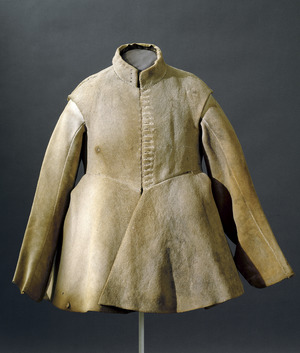Buff coat facts for kids

The European buff coat was a special type of leather clothing worn mostly by cavalry (soldiers on horseback) and officers in the 1600s. Some foot soldiers wore them too. People often wore buff coats under metal chest and back armor, called a cuirass, to make it more comfortable. The buff coat came from simpler leather jerkins that hunters and soldiers wore during the Tudor period. The name "buff coat" and its light tan color come from the buffalo or ox hide often used to make it.
Contents
Making and Looking at Buff Coats
Buff coats were part of military fashion in Europe from about 1600 to the 1680s. The word "buff" for the coat comes from leather made from "European buffalo," which was likely the wisent. This also gave the color buff its name. In the early 1600s, Germany was the only place to get buffalo leather. However, most buff coats were actually made from thick cowhide.
Even though they were military clothes, buff coats looked a bit like civilian styles from the early 1600s. They had a high waist and wide skirts that reached the thighs. They were similar to earlier sleeveless leather jackets called jerkins.
How Buff Coats Were Made
Buff coats could be made with or without sleeves. The very best ones were made from the hide of the European elk. To make "buff leather," a special method called "oil tanning" was used. First, the hide was treated with lime and scraped to remove the outer layer. This made the leather look dull, not shiny. Then, cod oil was worked into the hide in a process called "kicking." Finally, the leather was air-dried. These oiling and drying steps could be repeated. The finished leather got its special buff color and became soft, strong, and good at resisting bad weather.
Because the leather was so thick, the seams of these coats were joined end-to-end. The stitches were often hidden or partly hidden. Workers had to punch holes with an awl before stitching, because needles back then couldn't go through the thick hide. The buff coats that still exist today have linings, either made of rough linen or silk. They closed with laces, buttons, loops, or clasps. All the English buff coats we still have use hooks and eyes to close.
Many fancy buff coats looked like they had gold or silver strips down the front. But these were just for show! The real hooks and eyes were hidden inside. Some of the fanciest buff coats, often seen in paintings of officers, had many strips of gold or silver lace. These strips ran down or wrapped around the sleeves.
Different Styles of Buff Coats
Most buff coats that still exist have sleeves, but some do not. It was common for men's clothes in the 1600s to have sleeves that could be removed. Sleeves could be a single layer of leather from the shoulder to the wrist. Or, they could be a double layer from the shoulder to the elbow, and then a single layer to the wrist. This allowed for easier movement. All buff coats had deep skirts attached, which helped protect the wearer's upper legs. The thickest parts of the leather were usually placed to protect the legs when riding a horse.
A collection of buff coats from 1649–1660 at Littlecote House shows how much they could vary. The leather thickness ranges from about 1.5 millimeters to 5.6 millimeters. The whole coats weighed between 1.9 kilograms and 3.4 kilograms.
Using the Buff Coat in Battle
The buff coat offered some protection against cuts from swords and other sharp weapons. However, it wasn't very good at stopping stabs. It also didn't protect much from bullets, except maybe very weak ones.
Soldiers often wore the buff coat under their metal chest armor (the cuirass). This helped cushion them from the armor's edges, preventing rubbing or bruising. Soldiers also wore the buff coat by itself because it was much more comfortable for long periods than heavy metal armor. The best quality buff coats were expensive. They often cost more than the standard metal armor given to regular soldiers. This is why officers and wealthier men usually wore them.
During the Thirty Years' War and the English Civil War, some soldiers wore buff coats instead of full armor. Along with a lobster-tailed pot helmet and a cuirass, the buff coat was a key part of the equipment for a harquebusier. This was a common type of cavalry soldier in the 1600s. While some foot soldiers wore them, in battle, buff coats were mainly used by wealthy cavalry troops. A few musketeers in pike and shot armies also received buff coats. This gave them some protection during hand-to-hand combat. Buff coats were also worn by regular people who needed strong, protective clothing, like hunters or men traveling on horseback.
See also
- Gambeson, a padded jacket, worn alone as armor or with mail or plate armor
Images for kids
-
This painting shows Richard Neville, a Royalist cavalry officer from the English Civil War. He is wearing a buff coat under his chest armor. Notice the gold lace bands on his sleeves.



